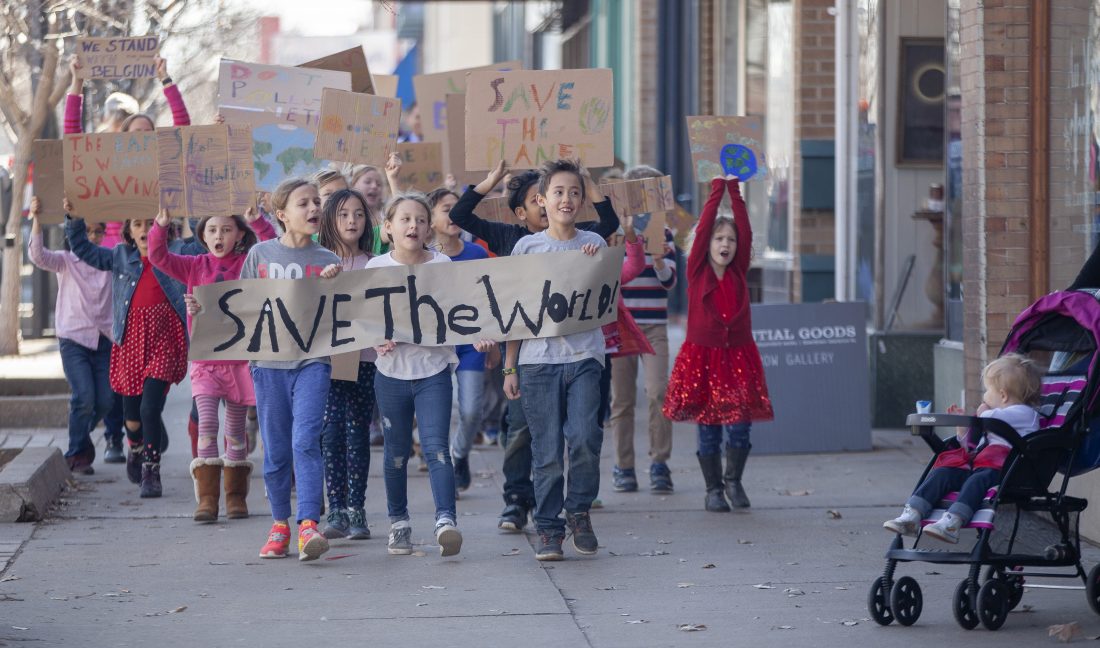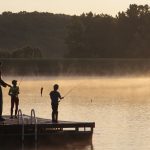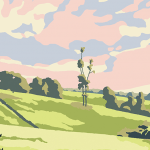
THE GLOBAL CLIMATE CRISIS IS CHANGING KANSAS AS WE KNOW IT AND UPENDING MY GENERATION’S ASSUMPTIONS ABOUT A FUTURE IN OUR HOME STATE.
For over 40 years, more than double my lifetime, the annual Prairie Festival at the Land Institute near Salina has celebrated the research station’s mission of developing viable perennial crops to foster more sustainable agriculture in the nation’s Great Plains and prairies. It is an overwhelmingly positive experience, rooted in the conviction that we can improve our future by improving our relationship with the land.
This past year, when I attended the festival as a high school student, the atmosphere seemed different. Inside a retrofitted barn where the festive square dances are held, I listened to a Q&A with Bill McKibben, one of the leading experts on climate change. The microphone came to a young audience member, maybe a couple years older than me, who said, “One thing which I think is interesting is that we youth are not organizing because we want to—we’re organizing because we’re terrified and afraid. … I don’t know if I’m going to have a world to grow up into. Do you have any tips for mitigating—or living with—climate depression?”
Standing there, I realized the question was both personal and collective; the youth asked for themself and for the many youth turning to older generations for help with the climate emergency we are inheriting. That young person could not have summed up my anxieties and fears any more succinctly. As things are shaping up, my generation will be growing into a transformed Kansas—a state scarred by natural disasters, submerged by floods, and shaken by environmental instability.
It is deeply distressing that, though the effects of climate change are already happening, alarming numbers of adults refuse to acknowledge the problem. Perhaps the issue still seems theoretical to them; perhaps they believe the expertise and consensus of scientists across the world are up for debate. But for Kansans my age, the climate crisis is an impending reality. Our state has no coastal cities at risk of being submerged into the ocean, and we might not face the forest fires that continue to ravage California, but Kansas is in danger.
“There was just this huge curtain of water that was coming right at us,” Ken Lassman says. “And somewhere in there, there was a tornado.” Lassman, author of Wild Douglas County and ecological expert, is describing the EF-4 tornado that skimmed the south edge of Lawrence on May 28, 2019. It was a close call for Lassman, too; the tornado carved its path only half a mile from his home, just southwest of the Wells Overlook. But this type of natural catastrophe will become more common: research by the National Climate Assessment warns that extreme weather events in the Great Plains will be exacerbated by climate change. “That means more heat waves, more droughts, more floods, more severe weather,” says Lassman, who adds that these predictions ought to disturb any Kansan: “All it takes is one catastrophic event to change the community you live in for decades.”
In Topeka, for example, the architecture on Washburn University’s campus is noticeably post-60s because the 1966 tornado razed the campus. In Lawrence, the 1951 Kansas River flooded sections of the city, leading to new zoning laws, river regulations and the creation of dams. These were generation-defining events for local communities, and my generation is likely to face several of them in our lifetime.
Extreme weather won’t be our only problem. Stan Cox, a geneticist at the Land Institute in Salina, warns that “the agricultural economy especially is going to really be hit pretty hard.” Crippling droughts and changing growth cycles will complicate farming and could result in a 20 percent decrease in productivity of corn in North America before 2050. And we’re already seeing the disruptive effects of climate change on our local agriculture and economy, according to Lassman. “Last year there were sections 100 miles north of here that didn’t get to plant their crops,” he notes, referring to spring 2019 floods in Nebraska caused by unusual amounts of rainfall and snowmelt before the ground could thaw completely. “Those communities were devastated by the impact of that on the economy.”
The shifting climate is also changing where certain crops can be grown. “Agriculture has these growth zones where they recommend plants … those have shifted,” says Lassman. That means some crops that used to flourish here will no longer be able to survive. “We already have what was normal climate in Wichita up here in northeast Kansas. So, it just keeps shifting. Is it going to be a smooth transition? No. It will be punctuated by these droughts and floods and unusually warm winters and all these different things.” The Kansas I’m growing up in might seem foreign to generations after me; the climate might not be the same, and it will certainly be less predictable.

As the world becomes hotter, Kansas will become drier, and drought will strain the already depleted water sources, like the Ogallala Aquifer, a massive underground water supply beneath the Great Plains. Agriculture in western Kansas depends heavily on the Ogallala for irrigation, and with less rain, this dependency will only increase. A study in Proceedings of the National Academy of Sciences showed that 30 percent of the aquifer had been drained by 2013, and we’re on course to drain it another 39 percent in the next 50 years. If this reckless consumption isn’t corrected, my generation and generations to come will be left with farmland bereft of a water source. And that shortage will send unanticipated and unpleasant ripples through the state’s economy and social stability.
Regarding both climate change and the exhaustion of the aquifer, Rex Buchanan, director emeritus of the Kansas Geological Survey at the University of Kansas, says, “they’re slow-motion crises; they’re the classic frog in boiling water analogy.” Buchanan is right. It’s easy for us to rally around something like fighting an invading army; it is harder to fight—or even acknowledge—a temperature rise that could slowly kill us. Maybe that lack of immediacy would be an understandable reason for community and government inaction—if we were living in 1990. But it’s 2020. The science is settled, and the warnings are clear: older generations will see the first effects of this crisis, and my generation will suffer through it. We are in immediate danger and there is a narrowing window for action. There are no more excuses; failure to acknowledge this crisis is intellectual dishonesty and a moral legerdemain that leave my generation to cope with the consequences. And as someone inheriting the ill-effects of climate change, I am infuriated to see scientists—whose whole job revolves around drawing objective conclusions from data—gainsaid by anti-intellectuals who simply prefer a more convenient narrative.
Meanwhile, each year puts my generation deeper into the climate crisis.
Sami Turner, an activist and 2020 Lawrence High School grad says, “When talking to my friends about the future and planning out what sort of career path we want to go into, and stuff like that, it’s always like ‘well, will that even be a possibility?’” Turner and I are in the same predicament. When I think of places to live as an adult, I must consider if that place will be underwater or vulnerable to forest fire or ravaged by heat or any number of increasingly likely disasters.
I don’t even have to look far to find climate refugees; my uncle and aunt moved to California in 2017 and subsequently lost their house in the Camp Fire; I’ve seen the before and after shots of their home just outside of Paradise, a normal suburban rancher reduced to scorched earth, their car’s liquefied hubcaps trickled onto pavement.
For many in my generation, events like the Camp Fire affect their conception of the world they are going to grow up into. “It definitely makes the future seem more bleak,” Turner adds. “People often talk about how younger people generally have a lot of hope and have that prospect of being better off than their parents were. I don’t know if our generation feels that way.”
This past fall, climate strikes took place across the world; when I walked through a strike in South Park, I saw hundreds of concerned young people. “FIGHT FOR MY FUTURE,” a sign read. Despite such an overwhelming amount of protest and alarm, little action has taken place, and we are contemplating a future with diminished hopes.
Harriet Lerner, a Lawrence-based clinical psychologist and New York Times bestselling author, wrote to me in an email for this story. “Teens have less confidence than other generations that the adults in their life will protect them,” she said. “Many teens observe their parents ignoring environmental concerns, and they observe our nation’s leaders at the top unravelling the protections put in place to help combat the problem.” It is hard to be hopeful with grim predictions about the future climate, and it is even harder to be hopeful when older generations cannot be bothered to act in their own—or our—interest. “Climate-induced anxiety is a big part of the anxious soup we are all swimming in,” adds Lerner.
As each day passes, the possibilities for a sustainable future diminish. Those of us whose future is being determined before we have the political or financial clout to determine it for ourselves feel the clock ticking. As Stan Cox says, “We don’t have time for those school-strikers to grow up and take this thing over.”
One approach to the climate crisis is to look at who is to blame for stalling progress. “Well it’s pretty clear: it’s money,” says Lassman. “People have made huge investments in the fossil fuel industry. I mean, tens and hundreds of billions of dollars, and they want a return on their investment.” While the protesters are in the streets, the fossil fuel lobbyists are in the Statehouse, countering measures that would reduce greenhouse gas emissions in favor of their profits.
But money isn’t the only culprit. Ignorance, misinformation, and downright apathy prevent many Americans from recognizing climate change as a problem. “It’s turned into your classic red vs. blue argument; you’re not going to solve anything if that’s the case,” says Buchanan. “It’s become a politicized issue to the point of inaction.” And there is indeed a clear partisan divide in the data showing the priority of action against climate change. “This ought to be an issue that people coalesce to deal with,” Buchanan adds. “Trying to figure out how to deal with it is hard enough if you all agree, let alone if half of you are calling the other half liars.”
This debate, if it was ever interesting or worthy of punditry, is now irrelevant. My generation will live in a Kansas and in a world altered by a climate crisis regardless of what is said on Sunday morning talk shows.
This should be the part of the essay where I offer the upside to the situation: the promise of renewable energy, the capacity of my generation to solve problems, the hope I feel when I see wind turbines twirling on the plains of western Kansas or solar panels shimmering in the sunlight. The problem isn’t completely unfixable, but we have to act. I wish I could say the outlook is hopeful—but it isn’t, and for my generation, it’s hard to be optimistic.
This brings me back to the barn near Salina, and the young person asking Bill McKibben for consolation about the growing climate emergency. They weren’t asking McKibben for help solving climate change—rather, just for help mitigating the depression it causes.
McKibben first told them about getting out into nature and experiencing the beauty of the world, but then, with regret, admitted that because of human harm to the environment, it’s getting harder to do even that. One of the few outlets to alleviate stress over climate change is now also being limited by climate change itself. “Sadly, we’re making some of those answers harder,” he said.
It was clear that if it were possible to give a hopeful, can-do answer to that young person, McKibben would have.
But he did something better.
He told the truth instead.
—STORY BY EVAN MCHENRY / Evan McHenry is a high school senior at Bishop Seabury Academy in Lawrence, Kansas


























